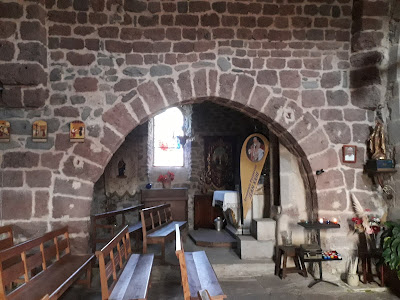
In the area around Le Puy are several small towns with Romanesque churches. These churches were built around the 11th century. This one is in the small town of Saint Geneys, located at a fork in the road on the D-906 highway and about 20 minutes north of Le Puy. It does not seem to be a functioning church--or at least one with the Blessed Sacrament--but the town takes care of it as a relic of its history and welcomes visitors with an open door to explore it and its architecture.
The small farming village of St. Geneys was founded in 1038 and the church was first mentioned in documents in 1164. Two centuries later it was dedicated to St. Barthélemy in 1336. There used to be a fort a short distance from here, built in the Middle Ages, but there is no evidence of its remains.
The church measures only 4200 square feet but it has evolved over the centuries and incorporated different architectural traditions into the same church.
The oldest part of the church is the north side, which actually dates back to the Romans who left an ossuary there. (The ossuary continued to be used as a depository for funereal bones until the 18th century.) Today, this part of the church stands as a side chapel (left of the altar) that provides more seating and an altar to the Blessed Mother.
 In the mid-16th century the apse was reconstructed in the Gothic tradition with ribbed vaults (ceiling) and flat-wall pilasters. Four chapels were added (north, south, east, west) as was a new door with an emblazoned pediment on the east side of the church.
In the mid-16th century the apse was reconstructed in the Gothic tradition with ribbed vaults (ceiling) and flat-wall pilasters. Four chapels were added (north, south, east, west) as was a new door with an emblazoned pediment on the east side of the church.

The bell tower was reconstructed in 1662.

During the French Revolution when churches were taken over by the state, this church was no exception. Afterward, the parish was re-started in its Catholic tradition.
 Between 1852-58 the curé, Fr. Monteillard, enlarged the small church and by extending the nave on its west side and building a new chapel on its south side. Along the nave are arches with a smoothed surface for paintings although none exist now. The
choir in the back of the church is out of line from the nave because
its walls were used to support a steeple that was reconstructed in the
17th century.
Between 1852-58 the curé, Fr. Monteillard, enlarged the small church and by extending the nave on its west side and building a new chapel on its south side. Along the nave are arches with a smoothed surface for paintings although none exist now. The
choir in the back of the church is out of line from the nave because
its walls were used to support a steeple that was reconstructed in the
17th century.
 The windows on the south side employ a more flamboyant Renaissance style. The stained glass window below was installed in 1938 depicting St. Louis XIII (1601-43) making vows. He was king of France 1610-43.
The windows on the south side employ a more flamboyant Renaissance style. The stained glass window below was installed in 1938 depicting St. Louis XIII (1601-43) making vows. He was king of France 1610-43.
The church was restored again 1981-82 and the sacristy was eliminated. However, a sarcophagus was found buried beneath it. Today it serves as a planter at the entrance of the church. Also discovered was a subterranean hall that had served as a Roman ossuary.
The priest assigned to this parish was named by the head priest or bishop of the Cathedral in Le Puy as well as the feudal lords in this area. This system of appointments went on until the French Revolution (1789-99).
Some
beautiful snow-capped mountains appeared in the distance in early
December. It snowed in Le Puy a week later but melted after only a day
on the ground.





No comments:
Post a Comment